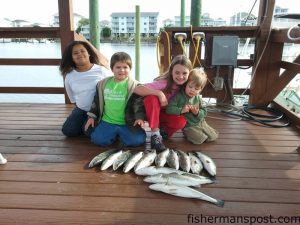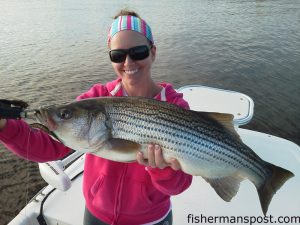Carolina Beach March 7, 2013

Jayla, Alex, Piper, and Adam with speckled trout they hooked on live shrimp in the Carolina Beach boat basin while fishing with their grandfathers Jay Hudson and Mark Miller.
Kyle, of Island Tackle and Hardware, reports that the wahoo and blackfin tuna bite is still solid for boats making the long run to the Gulf Stream (with fish to 87 lbs. weighed in recently). Ballyhoo under skirted trolling lures are fooling the majority of the ‘hoos. The ballyhoo will also attract attention from the tunas, but a smaller bait or lure incorporated in the spread is often a better choice.
The blue water action should remain solid as spring arrives, and other fish like dolphin and yellowfin tuna could make an appearance soon as well.
Not many people have been fishing between the beach and the Gulf Stream, but anglers venturing out to nearshore structure have been hooking big numbers of black sea bass (which are closed to harvest until June) along with some sheepshead and tautog. Shrimp on bottom rigs will get attention from all three of the bottom feeders.
Inshore, the red drum bite is on in the bays off the lower Cape Fear River. Most anglers are casting soft plastic baits to the reds with success.
Some speckled trout are also feeding in the lower river, but they’ve been scattered and tough to find on a consistent basis. Soft plastics and suspending MirrOlures are fooling the specks when anglers can find them. The trout bite should become more consistent as the water temperatures in the area climb over the next month.
Surf casters may be able to find some reds and trout in the breakers as well, where 52-Series MirrOlures will attract their attention.
Jeff, of Seahawk Inshore Fishing Charters, reports that there’s been a solid red and black drum bite recently in the backwaters off the lower Cape Fear River. Most of the fish are feeding around oyster beds and deeper holes in the creeks at lower tides. They’ve been a bit lethargic lately, and cut shrimp have been producing better results than artificials, although Gulp baits are also tempting some bites.
A few trout are also feeding in the creeks, where Gulp Jerkshads are getting their attention. The trout bite should get better over the coming weeks as the water temperatures rise a few degrees.

Shannon Clark with a 30″ striped bass that bit a D.O.A. soft plastic in the Cape Fear River near downtown Wilmington while she was fishing with her husband, Capt. Rennie Clark of Tournament Trail Charters.
Robert, of Carolina Explorer, reports that red and black drum are feeding in the creeks off the lower Cape Fear River. Scented baits like Gulps have been the best bets for both, and working them very slowly or even dead-sticking the lures is the way to tempt the drum to bite.
As the water temperatures rise over the coming weeks, the reds should get a little more active and begin feeding on the flats in the area.
Some speckled trout are also looking for meals in the river backwaters, but the bite’s been hit-or-miss. As soon as the water temperatures climb a bit and shrimp get on the move in the river, the trout bite will improve, and anglers going trout fishing can expect to do some catching as well. Soft plastic baits and suspending hard lures are the way to go for the specks.
Sea mullet have shown up in the mouth of the Cape Fear River, and anglers are starting to catch decent numbers while bottom fishing with fresh shrimp. The mullet bite will also improve as winter fades into spring.
Trevor, of ProFishNC Charters, reports that there are still striped bass feeding in the Cape Fear River, but they’ve been a bit elusive lately.
Red drum are also feeding way upriver, and anglers caught good numbers around structure in the northeast Cape Fear last week. Fresh shrimp and D.O.A. imitations both proved effective.
Reds are also holding around docks along the ICW. They’re fairly lethargic due to the cool water temperatures, so fresh cut shrimp are a better bet than artificial lures until the water warms up a bit. Docks with access to deeper water are more likely to be holding fish than those in the shallows.
